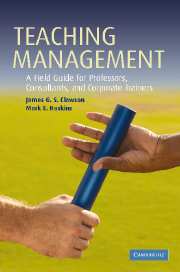Book contents
- Frontmatter
- Contents
- List of figures
- Sources to chapter quotations
- Why this book on teaching management?
- 1 Fundamental elements in teaching
- 2 Levels of learning: one, two, and three
- 3 Adult learning theory: it matters
- 4 Planning a course: trips and tips
- 5 Planning a class: no detail is too small
- 6 Lecturing: the possibilities and the perils
- 7 Managing discussions
- 8 Case method: fostering multidimensional learning
- 9 Role-playing
- 10 Case writing: crafting a vehicle of interest and impact
- 11 Case teaching notes: getting from here to there
- 12 Action learning
- 13 Experiential methods
- 14 Enhancing the conversation: audiovisual tools and techniques
- 15 Executive education: contributing to organizational competitive advantage
- 16 Using technology to teach management
- 17 Counseling students
- 18 Evaluating students: the twin tasks of certification and development
- 19 Teaching evaluations: feedback that can help and hurt
- 20 Research presentations
- 21 Managing a degree program: behind the ‘glory’
- 22 Managing a nondegree client program: an overview
- 23 Dealing with the press
- 24 Managing yourself and your time
- 25 Using teaching portfolios and course portfolios
- 26 Conclusion: is this on the exam?
- Index
9 - Role-playing
Published online by Cambridge University Press: 25 February 2010
- Frontmatter
- Contents
- List of figures
- Sources to chapter quotations
- Why this book on teaching management?
- 1 Fundamental elements in teaching
- 2 Levels of learning: one, two, and three
- 3 Adult learning theory: it matters
- 4 Planning a course: trips and tips
- 5 Planning a class: no detail is too small
- 6 Lecturing: the possibilities and the perils
- 7 Managing discussions
- 8 Case method: fostering multidimensional learning
- 9 Role-playing
- 10 Case writing: crafting a vehicle of interest and impact
- 11 Case teaching notes: getting from here to there
- 12 Action learning
- 13 Experiential methods
- 14 Enhancing the conversation: audiovisual tools and techniques
- 15 Executive education: contributing to organizational competitive advantage
- 16 Using technology to teach management
- 17 Counseling students
- 18 Evaluating students: the twin tasks of certification and development
- 19 Teaching evaluations: feedback that can help and hurt
- 20 Research presentations
- 21 Managing a degree program: behind the ‘glory’
- 22 Managing a nondegree client program: an overview
- 23 Dealing with the press
- 24 Managing yourself and your time
- 25 Using teaching portfolios and course portfolios
- 26 Conclusion: is this on the exam?
- Index
Summary
I have always thought the actions of men [are] the best interpreters of their thoughts.
– John LockeRole-playing can stimulate learning by bringing abstract conceptions alive for students, push them to focus on significant details that they otherwise might ignore, help them to see others' points of view, help them see the differences between concept and reality, provide on-thespot variety in the classroom, and give enormously useful data to an instructor. Whether role-plays are set up extemporaneously as the opportunity arises or planned for and managed well in advance, they are a valuable teaching tool for any instructor's repertoire. This chapter outlines some of the benefits of role-playing and addresses some important role-playing issues such as when to use the technique, how long to use it, how to set up role-plays and assign roles, and how to effectively debrief participants.
Benefits of role-playing
Role-plays can dramatically galvanize a sleepy class into one charged with attention and the electricity of concentrated learning. The pressure of having to present your ideas in a simulated, but live, conversation often causes students to think more deeply, more quickly, and more emotionally than they do when they present their ideas as part of a detached, impersonal analysis.
Role-plays are an excellent avenue for bringing abstract discussions and action plans alive for students. Without role-plays, students can easily gloss over the implementation issues in their proposed action plans. When students remain concerned only with the concepts, they often talk in poorly examined abstractions and assumptions.
- Type
- Chapter
- Information
- Teaching ManagementA Field Guide for Professors, Consultants, and Corporate Trainers, pp. 141 - 153Publisher: Cambridge University PressPrint publication year: 2006
- 1
- Cited by

